2019 MERCEDES-BENZ SLC ROADSTER airbag
[x] Cancel search: airbagPage 48 of 306
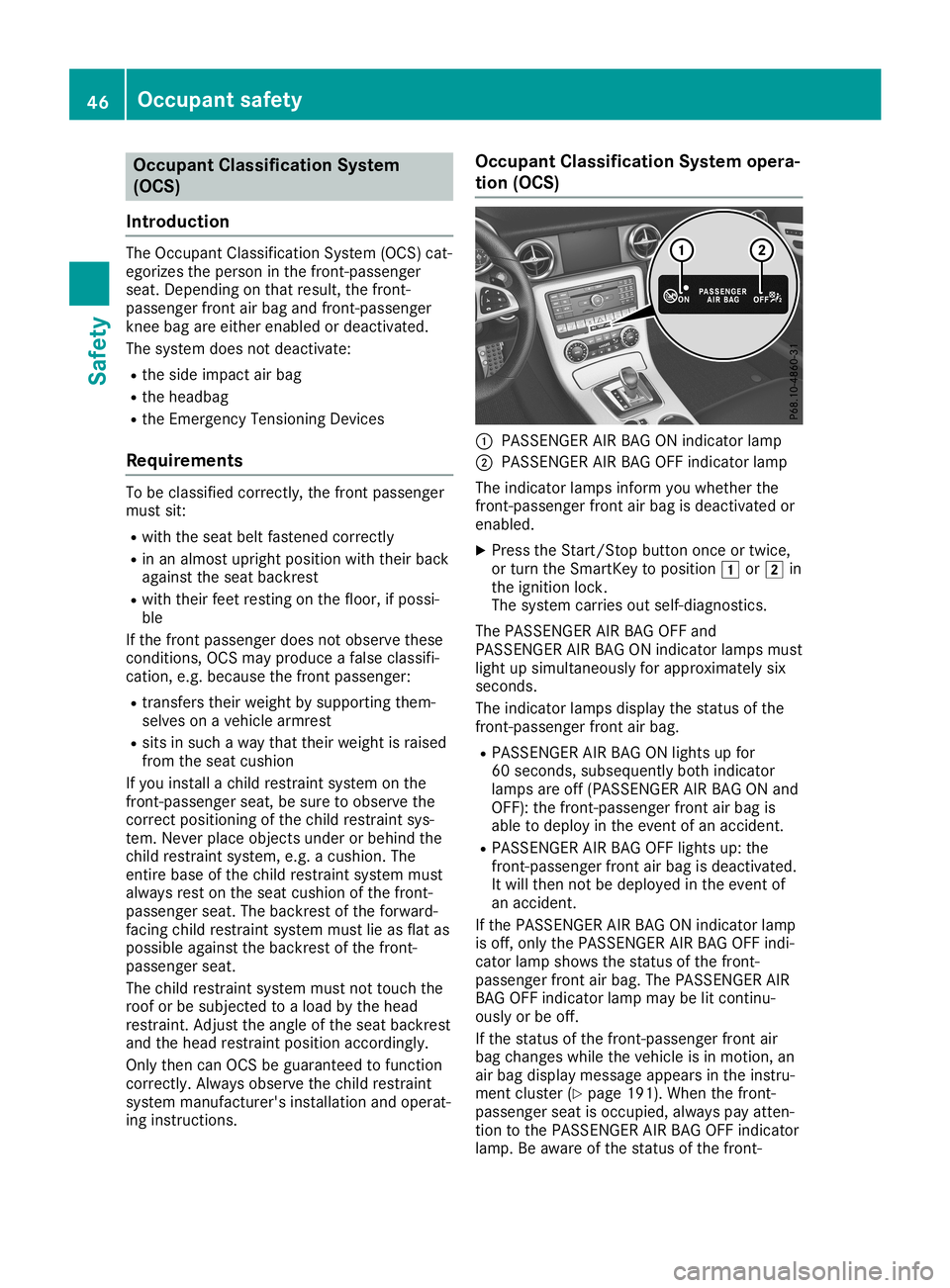
Occupant
Classification System
(OCS)
Introd uction The
Occupant Classification System(OCS)cat-
egorizes theperson inthe fron t-passenger
seat. Depen dingonthat result, thefron t-
passenger frontair bag and front-passenger
kn ee bag areeither enabled ordeactivat ed.
The system doesnotdeactivat e:
R the side impact airbag
R the headbag
R the Emer gencyTension ingDevic es
Requ irement s To
be classified correctly,the fron tpassenger
must sit:
R with theseat beltfasten edcorr ectly
R in an almost upright position withtheir back
against theseat backr est
R with their feetrestin gon the floor, ifpossi-
ble
If the fron tpassenger doesnotobserve these
con ditions ,OCS mayproduce afalse classifi-
cation ,e.g. because thefron tpassenger:
R tran sfers theirweight bysupportin gthem-
selves onavehicle armrest
R sits insuch away that their weight israised
from theseat cushion
If you installachild restraint system onthe
fron t-passenger seat,besure toobserve the
corr ectposition ingofthe child restraint sys-
tem. Never placeobjectsunder orbehind the
child restraintsystem, e.g.acushion. The
ent irebase ofthe child restraint system must
alway srest onthe seat cushion ofthe fron t-
passenger seat.Thebackr estofthe forward-
facing childrestraint system mustlieasflat as
possible againstthebackr estofthe fron t-
passenger seat.
The child restraintsystem mustnottouch the
roof orbe subject edtoaload bythe head
rest raint .Adj ust the angle ofthe seat backr est
and thehead restraintposition accordingly.
Only thencanOCS beguaranteed tofunc tion
corr ectly.Always observe thechild restraint
system manufact urer'sinstallation andoperat-
ing inst ruct ions. Occupant
Classification Systemopera-
tion (OCS) 0043
PAS SENGER AIRBAG ONindicat orlamp
0044 PAS SENGER AIRBAG OFFindicat orlamp
The indicat orlamps informyou whether the
fron t-passenger frontair bag isdeactivat edor
enabled.
X Press theStart/ Stop button onceor twice,
or turn theSmart Keytoposition 0047or0048 in
the ignition lock.
The system carriesoutself-diagn ostics.
The PASSENGER AIRBAG OFFand
PAS SENGER AIRBAG ONindicat orlamps must
light upsimultaneously forapproximat elysix
secon ds.
The indicat orlamps display thestatusofthe
fron t-passenger frontair bag.
R PAS SENGER AIRBAG ONlights upfor
60 secon ds,subsequently bothindicat or
lamps areoff(PASS ENGERAIR BAG ONand
OFF): thefron t-passenger frontair bag is
able todeploy inthe event ofan acciden t.
R PAS SENGER AIRBAG OFFlights up:the
fron t-passenger frontair bag isdeactivat ed.
It will then notbedeployed inthe event of
an acciden t.
If the PAS SENGER AIRBAG ONindicat orlamp
is off, only thePAS SENGER AIRBAG OFFindi-
cator lampshows thestatusofthe fron t-
passenger frontair bag. ThePASSENGER AIR
BAG OFFindicat orlamp maybelitcon tinu-
ously orbe off.
If the statusofthe fron t-passenger frontair
bag changes whilethevehicle isin motion ,an
air bag display message appearsinthe instru-
ment cluster (Ypage 191). When thefron t-
passenger seatisoccupied, alwayspay atten -
tion tothe PAS SENGER AIRBAG OFFindicat or
lamp. Beaware ofthe statusofthe fron t- 46
Occupant
safetySafet y
Page 49 of 306

passenger
frontair bag both before andduring
the journ ey. G
WARN
ING
If the PAS SENGER AIRBAGOFF indicat or
lamp islit, the fron t-passenger frontair bag
is disabled. Itwill notbedeployed inthe
event ofan acciden tand cann otperfor mits
int ended protective func tion.A person inthe
fron t-passenger seatcould then,for exam-
ple, come intocon tact with thevehicle's
int erior, especially ifthe person issitt ing too
close tothe dashboard. Thisposes an
incr eased riskofinjury oreven fatalinjury.
When thefron t-passenger seatisocc upied,
always ensure that:
R the classific ationofthe person inthe
fron t-passenger seatiscorr ectand the
fron t-passenger frontair bag isenabled or
disabled inaccor dance withtheperson in
the fron t-passenger seat
R the fron t-passenger seathasbeen moved
back asfar back aspossible.
R the person isseated correctly.
Make sure,bothbefore andduring thejour-
ney, thatthestatusofthe fron t-passenger
fron tair bag iscorr ect. G
WARN
ING
If you secure achild inarearward-f acing
child restraint system onthe fron t-
passenger seatandthePAS SENGER AIR
BA GOFF indicat orlamp isoff, thefron t-
passenger frontair bag candeploy inthe
event ofan acciden t.The child could be
str uck bythe airbag. Thisposes an
incr eased riskofinjury oreven fatalinjury.
Make surethatthefron t-passenger frontair
bag hasbeen deactiv ated.ThePASSENGER
AIR BAGOFF indicat orlamp must belit.
NEV ERuse arearward-f acingchildrestraint
on aseat prote cted byan ACTIVE FRONT
AIRB AGinfron tof it;DE ATH orSERIOUS
INJURY tothe child canoccur.
If the PAS SENGER AIRBAGOFF indicat orlamp
stays off,donot installarearward-f acingchild rest
raint system onthe fron t-passenger seat.
You canfind more information onOCS under
"Problems withtheOcc upant Classification
System "(Y page 49). G
WARN
ING
If you secure achild inaforward- facingchild
rest raint system onthe fron t-passenger seat
and youposition thefron t-passenger seat
too close tothe dashboard, inthe event of
an acciden t,the child could:
R come intocon tact with thevehicle's inte-
rior ifthe PAS SENGER AIRBAGOFF indi-
cator lampislit, for example
R be struck bythe airbag ifthe
PAS SENGER AIRBAGOFF indicat orlamp
is off
This poses anincr eased riskofinjury or
even fatalinjury.
Move thefron t-passenger seatasfar back
as possible. Alwaysmakesurethatthe
shoulder beltstrap iscorr ectlyrouted from
the vehicle beltguide tothe shoulder belt
guide onthe child restraint system. The
shoulder beltstrap must berouted forwards
and downwards fromthevehicle beltguide.
Always observe thechild restraint system
manufact urer'sinstallation instruct ions.
If OCS determ inesthat:
R The front-passenger seatisunocc upied, the
PAS SENGER AIRBAGOFF indicat orlamp
lights upafter theself-t estand remains lit.
This indicat esthat thefron t-passenger front
air bag isdeactiv ated.
R The front-passenger seatisocc upied bya
child ofup totwelve monthsold, inastan d-
ard child restraint system, thePAS SENGER
AIR BAGOFF indicat orlamp lights upafter
the self-t estand remains lit.This indicat es
that thefron t-passenger frontair bag is
deactiv ated.
But even inthe case ofatwelve- month-old
child, inastan dard child restraint system,
the PAS SENGER AIRBAGOFF indicat or
lamp cangoout after theself-t est.This indi-
cates thatthefron t-passenger frontair bag
is activ ated. Theresult ofthe classific ation
is dependen ton, among otherfactors, the
child restraint system andthechild's stat- Occupant
safety
47Safet y Z
Page 51 of 306
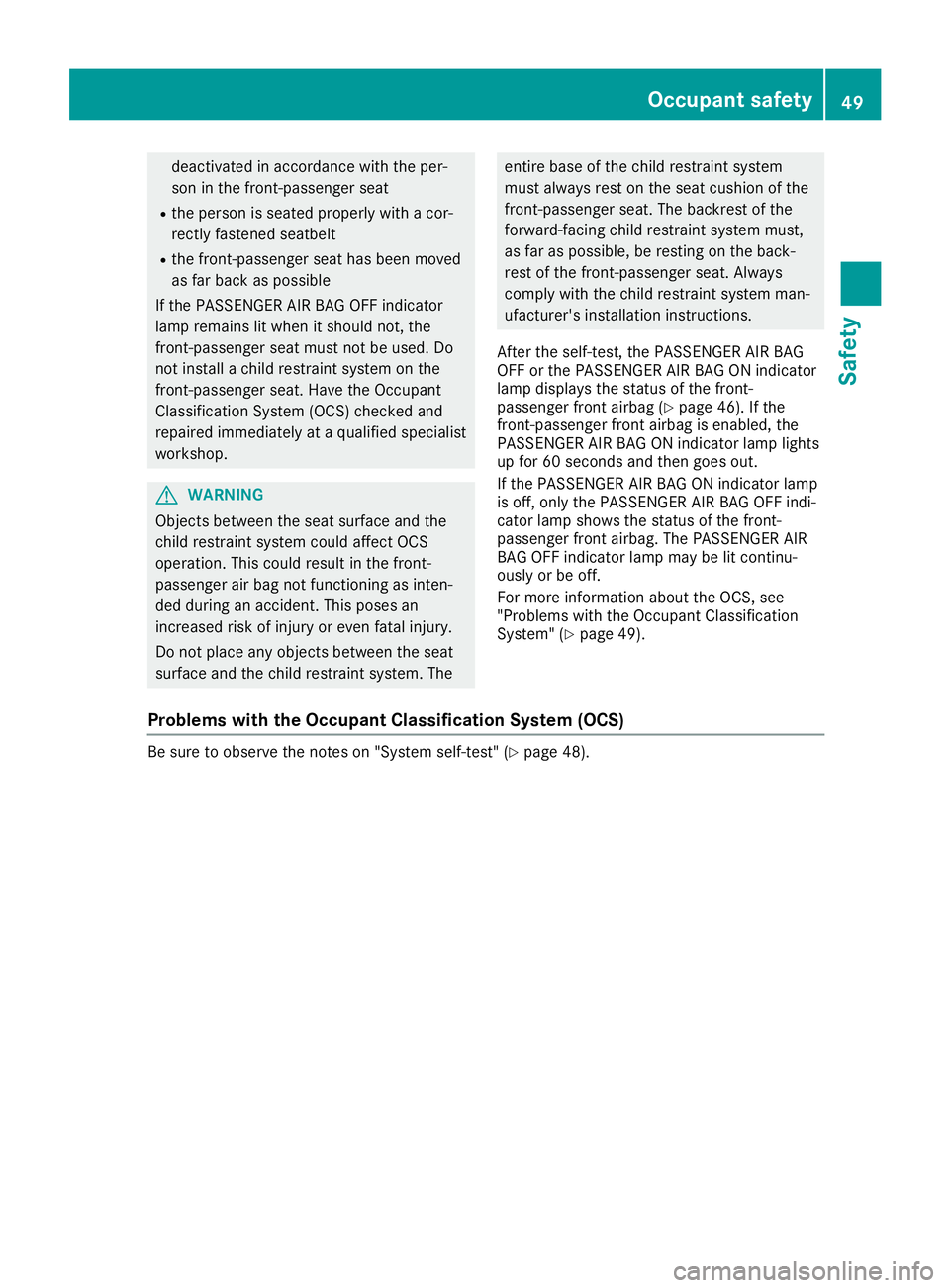
deactiv
atedinaccor dance withtheper-
son inthe fron t-passenger seat
R the person isseated properly withacor-
rect lyfasten edseatbelt
R the fron t-passenger seathasbeen moved
as far back aspossible
If the PAS SENGER AIRBAGOFF indicat or
lamp remains litwhen itshould not,the
fron t-passenger seatmust notbeused. Do
not installachild restraint system onthe
fron t-passenger seat.Have theOcc upant
Classification System(OCS)checkedand
repaired immediately ataqualified specialist
worksh op. G
WARN
ING
Objec tsbetween theseat surface andthe
child restraint system couldaffect OCS
operation .This could result inthe fron t-
passenger airbag notfunc tioningasinten-
ded during anacciden t.This poses an
incr eased riskofinjury oreven fatalinjury.
Do not place anyobjec tsbetween theseat
surface andthechild restraint system. The ent
irebase ofthe child restraint system
must always restonthe seat cushion ofthe
fron t-passenger seat.Thebackr estofthe
forward- facingchild restraint system must,
as far aspossible, berest ingonthe back-
rest ofthe fron t-passenger seat.Always
comply withthechild restraint system man-
ufactur er'sinstallation instruct ions.
Aft erthe self-t est,thePAS SENGER AIRBAG
OFF orthe PAS SENGER AIRBAGON indicat or
lamp displays thestatusofthe fron t-
passenger frontairbag (Ypage 46).Ifthe
fron t-passenger frontairbag isenabled, the
PAS SENGER AIRBAGON indicat orlamp lights
up for 60secon dsand then goes out.
If the PAS SENGER AIRBAGON indicat orlamp
is off, only thePAS SENGER AIRBAGOFF indi-
cator lampshows thestatusofthe fron t-
passenger frontairbag. ThePASSENGER AIR
BA GOFF indicat orlamp maybelitcon tinu-
ously orbe off.
For more information abouttheOCS, see
"Problems withtheOcc upant Classification
System "(Y page 49).
Problems withtheOccupant Classification System(OCS) Be
sure toobserve thenoteson "System self-test"(Ypage 48). Occupant
safety
49Safet y Z
Page 52 of 306
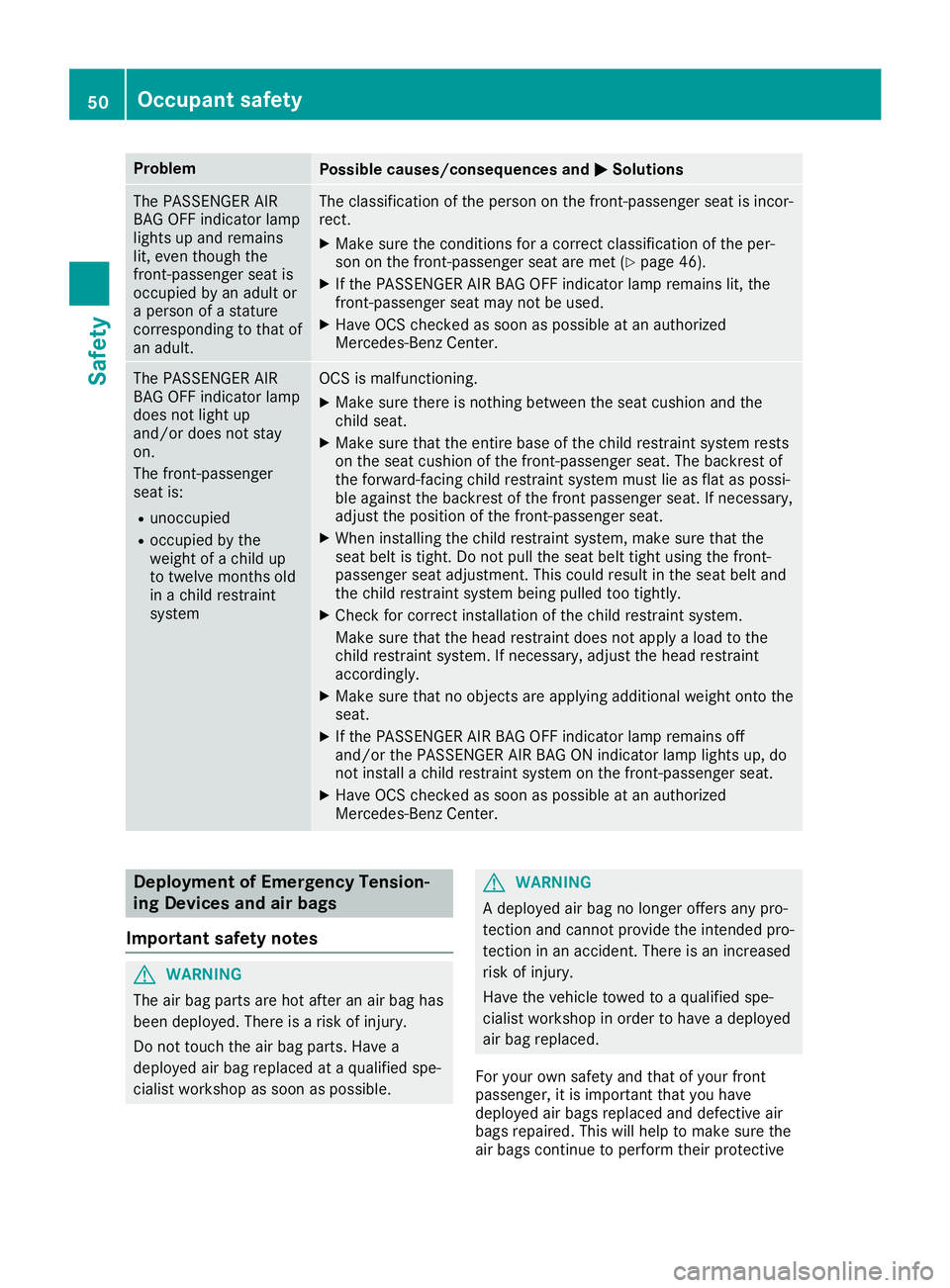
Problem
Possible
causes/co nsequences and0050 0050
Solutions The
PASS ENGER AIR
BAG OFFindicator lamp
lights upand remains
lit, even though the
front -passenger seatis
occupied byan adult or
a person ofastature
correspondin gto that of
an adult. The
classification ofthe person onthe front -passenger seatisincor-
rect.
X Make surethecondition sfor acorrect classification ofthe per-
son onthe front -passenger seataremet (Ypage 46).
X Ifthe PASS ENGER AIRBAG OFFindicator lampremains lit,the
front -passenger seatmaynotbeused.
X Have OCScheck edassoon aspossible atan authorized
Mercedes-Ben zCenter. The
PASS ENGER AIR
BAG OFFindicator lamp
does notlight up
and/or doesnotstay
on.
The front -passenger
seat is:
R unoccupied
R occupied bythe
weight ofachild up
to twelve monthsold
in achild restraint
system OCS
ismalfunctionin g.
X Make surethere isnothin gbetween theseat cushion andthe
child seat.
X Make surethattheentire baseofthe child restraint systemrests
on the seat cushion ofthe front -passenger seat.Thebackrest of
the forward-facing childrestraint systemmustlieasflat aspossi-
ble against thebackrest ofthe front passenger seat.Ifnecessary,
adjust theposition ofthe front -passenger seat.
X When installing thechild restraint system,makesurethatthe
seat beltistight. Donot pull theseat belttight using thefront -
passenger seatadjustment .This could result inthe seat beltand
the child restraint systembeingpulled tootightly.
X Check forcorrect installation ofthe child restraint system.
Make surethatthehead restraint doesnotapply aload tothe
child restraint system.Ifnecessary, adjustthehead restraint
accordingly.
X Make surethatnoobject sare apply ingadditional weightontothe
seat.
X Ifthe PASS ENGER AIRBAG OFFindicator lampremains off
and/or thePASS ENGER AIRBAG ONindicator lamplights up,do
not install achild restraint systemonthe front -passenger seat.
X Have OCScheck edassoon aspossible atan authorized
Mercedes-Ben zCenter. Deployment
ofEmergency Tension-
ing Devic esand airbags
Import antsafety notes G
WARNING
The airbag parts arehot after anair bag has
been deploye d.There isarisk ofinjury.
Do not touch theairbag parts. Havea
deploye dair bag replaced ataquali fiedspe-
cialist workshop assoon aspossible. G
WARNING
A deploye dair bag nolonger offersanypro-
tect ionand cannot provide theinten dedpro-
tect ioninan accident. Thereisan increased
risk ofinjury.
Have thevehicle towedtoaquali fiedspe-
cialist workshop inorder tohave adeploye d
air bag replaced.
For your ownsafety andthat ofyour front
passenger, itis important thatyouhave
deploye dair bags replaced anddefective air
bags repaired. Thiswillhelp tomake surethe
air bags continue toperform theirprotect ive 50
Occ
upantsafetySafety
Page 53 of 306

function
forthe vehicl eoccupa ntsinthe event
of acrash. G
WARNING
Emergency TensioningDevices thathave
depl oyedpyro technical lyare nolonge r
opera tional andareunab leto perform their
intended protective function.Thispose san
increas edrisk ofinjury oreven fatalinjury .
Have pyrotechnical lytrigger edEmergency
Tensio ningDevices replaced immed iatelyat
a qua lified speci alist worksho p.
An electric motor isuse dby PRE-SAFE ®
to
trigger thetightening ofthe seatbel tin haz-
ardo ussitua tions. Thisproced ureisreversi ble.
If Emergency TensioningDevices aretrigger ed
or air bag sare depl oyed,you willhea ra bang,
and some powdermay alsobe rele ased.The
0075 restrai ntsystem warning lamplig hts up.
Only inrare cases willthe bang affect your
hea ring. Thepowderthat isrele asedgenera lly
does notconstitute ahea lthhaza rd,but itmay
caus eshort-term breathing difficulti esinpeo-
ple with asthma orother respiratory problems.
Provid editis safe todo so, you shou ldlea ve
the vehicl eimmed iatelyor open thewind owin
order toprevent breathing difficulti es.
Air bag sand pyro technic Emergency Tension-
ing Devices (ETDs)contain perchloratemate-
rial ,whi chmay requirespeci alhandl ingand
rega rdfor the environment. Nationalguide-
lines must beobse rved duringdisp osal.In Ca l-
ifornia ,see www.dtsc.c a.gov/
HazardousWaste/ Perchlorate/i ndex.cfm.
Method ofoperatio n During
thefirst stage ofacolli sion, the
restrai ntsystem controlunitevaluates impo r-
tant physical datarelating tovehicl edecel era-
tion oraccele ration, suchas:
R dura tion
R dire ction
R intensity
Based onthe eval uation ofthis data ,the
restrai ntsystem controlunittrigger sthe Emer-
gency TensioningDevices duringahea d-on or
rear-end collision. An
Emergency TensioningDevice canonly be
trigger ed,if:
R the igniti onisswi tched on
R the components ofthe restrai ntsystem are
opera tional.You canfind further informa tion
under "Restrai ntsystem warning lamp"
(Y pag e39)
R the seatbel tbuckle tongue hasengag edin
the beltbuckle ofthe respe ctiveseat
If the restrai ntsyste mcontrol unitdetects a
more severe accident,further components of
the restrai ntsyste mare activa tedindep end-
ently ofeach other incertain frontalcollision
situa tions:
R Front airbag sas wel las drive r'sand front-
pas senger kneebags
Dependi ngon the perso nin the front-
pas senger seat,the front-passe ngerfront air
bag iseither enabledordisa bled.The front-
pas senger frontairbag canbedepl oyedin an
accid entonly ifthe PASSENGER AIRBAG OFF
indica torlam pis off. Obser vethe informa tion
on the PASSENGER AIRBAG indica torlam ps
(Y pag e39) .
You rvehicl ehas two-stage frontairbag s.
The activa tionthreshol dof the Emergency
Tensio ningDevices andtheairbag sis deter-
mined byeval uating therate ofvehicl edecel -
erati onoraccele rationwhichoccurs atvari ous
poi nts inthe vehicl e.This process ispre-emp -
tive innature. Deployment shouldtake place
in good timeatthe start ofthe colli sion.
The rate ofvehicl edecel erationoraccele ra-
tion andthedirection ofthe force areessen-
tial lydetermi nedby:
R the distri butionofforces duringthe colli sion
R the colli sion angle
R the deforma tionchara cteristics ofthe vehi-
cle
R the chara cteristics ofthe object withwhich
the vehicl ehas collided
Factors whichcan only beseen andmeas ured
after acolli sion hasoccurred donot playa
decis iverole inthe depl oyme ntofan air bag .
Nor dothey provi deanindica tionofair bag
depl oyme nt.
The vehicl ecan bedeforme dconside rably,
witho utan air bag being depl oyed.This isthe
case ifonly parts whichare relatively easily
deforme dare affected andtherate ofdecel er-
ation isnot high .Convers ely,air bag smay be
depl oyedeven though thevehicl esuffe rsonly Oc
cupant safety
51Safety Z
Page 54 of 306
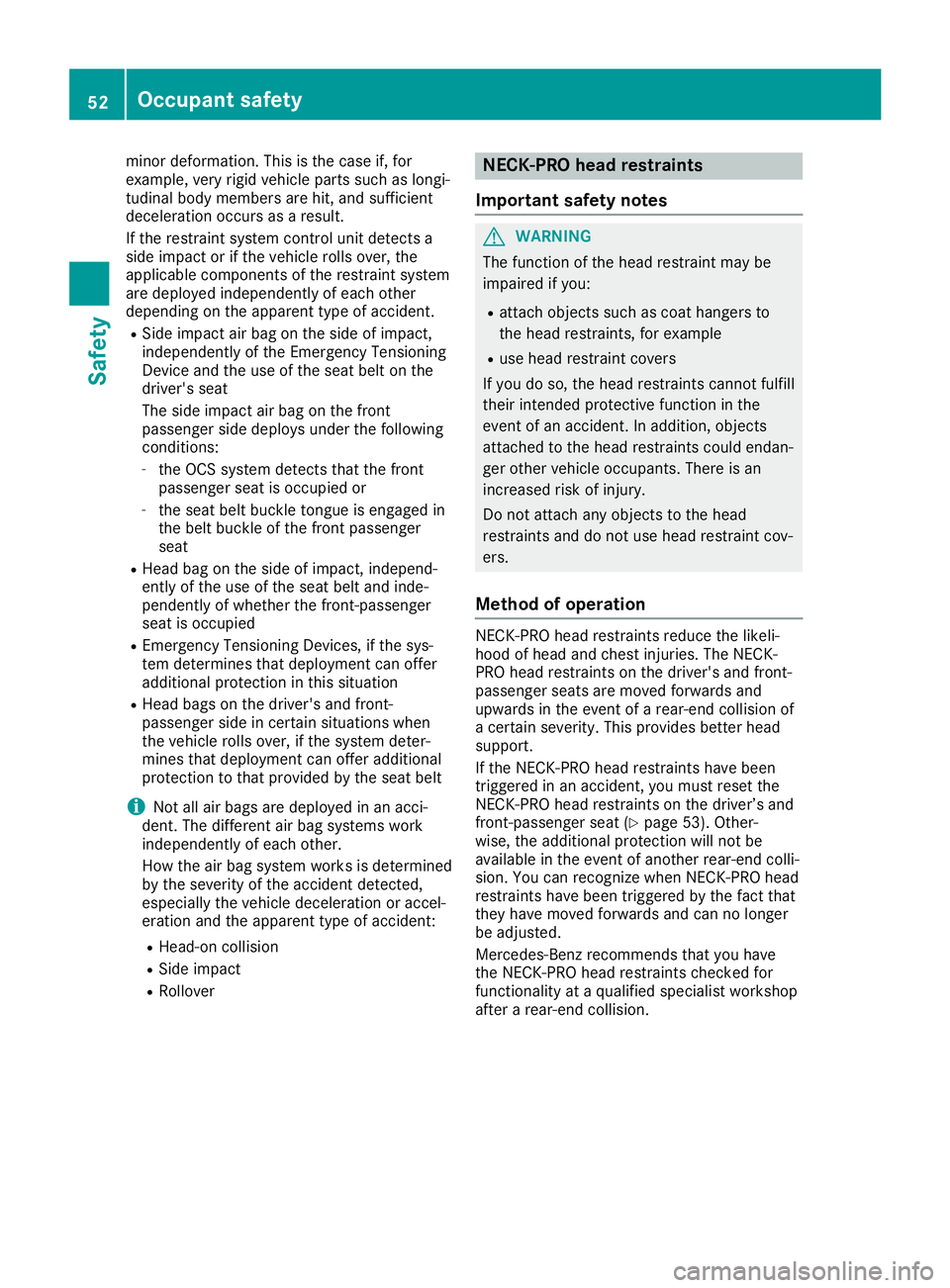
minor
deforma tion.Thisisthe case if,for
exampl e,very rigid vehicl eparts suchaslongi-
tudina lbody members arehit,and suffici ent
decel eratio noccurs asaresul t.
If the restraint systemcontrolunitdetects a
side impa ctor ifthe vehicl erolls over, the
app licable components ofthe restraint system
are depl oyedindepe ndently ofeach other
depe nding onthe apparent typeofaccide nt.
R Side impactair bag onthe side ofimpa ct,
indepe ndently ofthe Emergency Tensioning
Device andtheuse ofthe seat beltonthe
driver' sseat
The side impa ctair bag onthe front
pass enger sidedeploysunder thefollo wing
conditions:
- the OCS system detects thatthefront
pass enger seatisoccupi edor
- the seat beltbuckle tongue isengage din
the belt buckle ofthe front passenger
seat
R Head bagonthe side ofimpa ct,indepe nd-
ently ofthe use ofthe seat beltandinde-
pendently ofwhethe rthe front-passenger
seat isoccupi ed
R Emergency TensioningDevices, ifthe sys-
tem determines thatdeployme ntcan offer
add itional protection inthis situa tion
R Head bagsonthe driver' sand front-
pass enger sideincertain situations when
the vehicl erolls over, ifthe system deter-
mines thatdeployme ntcan offer additional
protection tothat provid edbythe seat belt
i Not
allair bags aredepl oyedin an acci-
dent. Thediffere ntair bag systems work
indepe ndently ofeach other.
How theairbag system worksisdetermined
by the severi tyof the accide ntdetected,
especi allythe vehicl edecel eratio nor accel-
eratio nand theapparent typeofaccide nt:
R Head-on collision
R Side impact
R Rol lover NECK
-PROhead restraints
Important safetynotes G
WARNING
The function ofthe head restraint maybe
impa iredifyou :
R attach objects suchascoat hangers to
the head restraints, forexampl e
R use head restraint covers
If you doso, the head restraints cannotfulfill
their intended protective functioninthe
event ofan accide nt.Inadd ition, objects
attached tothe head restraints couldendan-
ger other vehicleoccupa nts.There isan
increase drisk ofinjury.
Do not attach anyobjects tothe head
restraints anddonot use head restraint cov-
ers.
Method ofoperation NECK-PRO
headrestraints reducethe likel i-
hood ofhead andchest injurie s.The NECK-
PRO head restraints onthe driver' sand front-
pass enger seatsaremoved forwardsand
upw ards inthe event ofarear-end collision of
a certain severity.This provid esbetter head
supp ort.
If the NECK-PRO headrestraints havebeen
triggere din an accide nt,you must reset the
NECK-PRO headrestraints onthe driver’ sand
front-passenger seat(Ypage 53).Other-
wise ,the additional protection willnot be
avai lablein the event ofanother rear-end colli-
sion. Youcanrecognize whenNECK-PRO head
restraints havebeen triggered bythe fact that
they have moved forwardsand cannolonger
be adju sted.
Mercede s-Benzrecommends thatyouhave
the NECK-PRO headrestraints checkedfor
functionali tyat aqua lified specia listworkshop
after arear-end collision. 52
Occ
upant safetySafety
Page 58 of 306
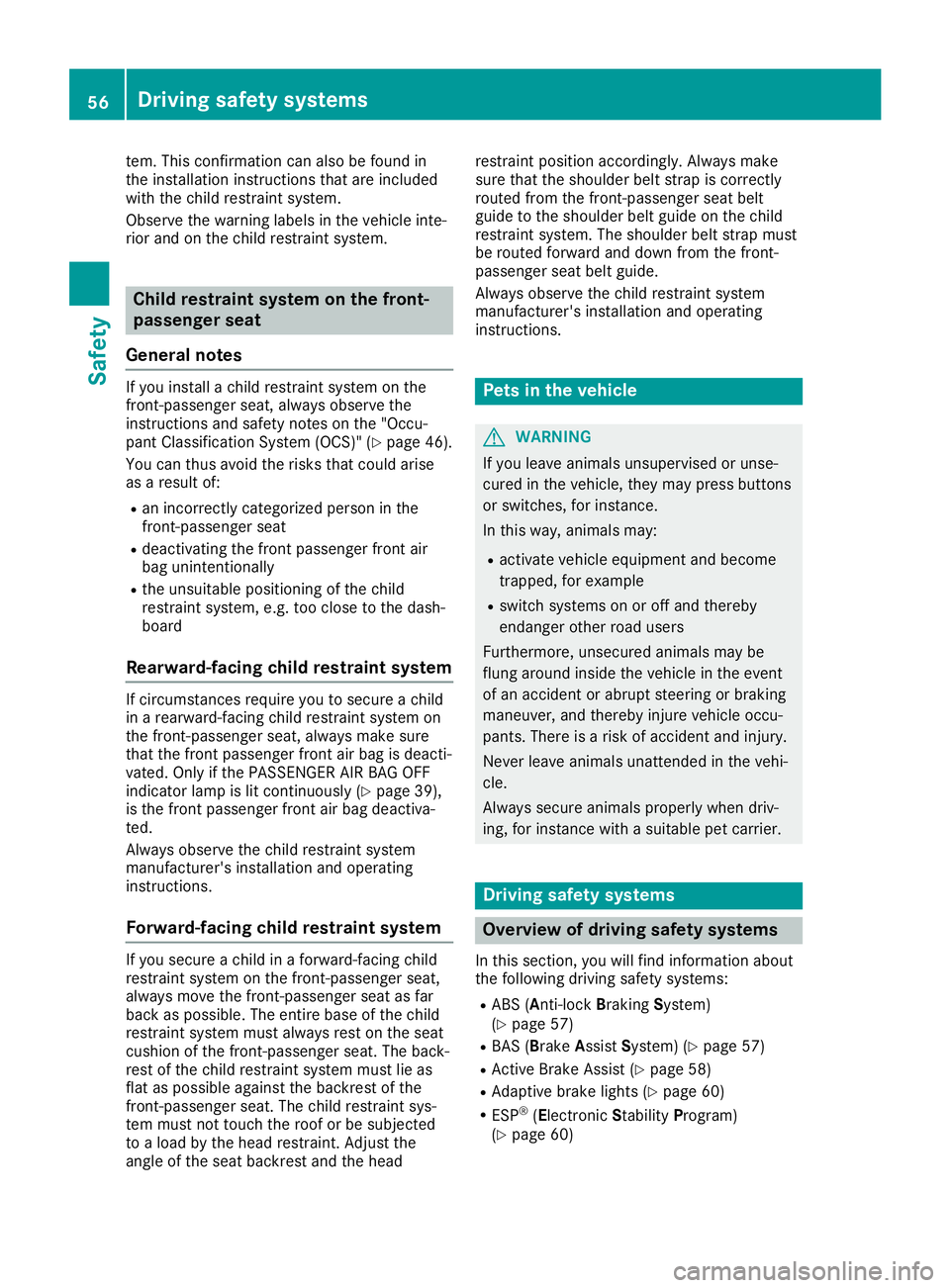
tem.
Thisconfi rmationcan also be fou ndin
the installatio nins tructio nstha tar eincl uded
wi th the childres traint syste m.
Ob serve the warning labe lsin the vehicleinte -
rio rand onthe childres traint syste m. Ch
ild res train tsys tem onthe front-
pass engerse at
Ge neral notes If
yo uins talla chi ldres traint syste mon the
fro nt-pa ssenge rse at, alwa ysobserve the
ins tructio nsand safety note son the "Occu -
pa nt Clas sific ati on Sys tem (OCS) "(Y page 46) .
Yo ucan thusav oid the risks tha tcou ldarise
as ares ultof:
R an inco rrectly cate gorized perso nin the
fro nt-pa ssenge rse at
R de acti vating thefrontpasse nge rfro ntair
ba guni ntenti onally
R the unsuitab lepo sitio ning ofthe child
res traint syste m, e.g.too closetothe dash-
bo ard
Rea rwa rd-fac ingch ild res train tsys tem If
cir cum stances require youto secur eachi ld
in area rward-fa cing childres traint syste mon
the front-pa ssenge rse at, alwa ysma kesure
tha tthe frontpasse nge rfro ntairba gis de acti -
va ted .Onl yif the PASSEN GERAIRBAG OFF
ind icator lamp islit conti nuously(Y page 39),
is the frontpasse nge rfro ntairba gde acti va-
ted .
Alw aysob serve the childres traint syste m
ma nuf actu rer'sins tallatio nand opera ting
ins tructio ns.
Fo rwa rd-fac ingch ild res train tsys tem If
yo use cur eachi ldinafor wa rd-f acing child
res traint syste mon the front-pa ssenge rse at,
al wa ysmov ethe front-pa ssenge rse at as far
ba ck aspossi ble. The entirebase ofthe child
res traint syste mmu stalwa ysres ton the seat
cus hion ofthe front-pa ssenge rse at. The back-
res tof the childres traint syste mmu stlie as
fla tas possi ble ag ainst the backre stof the
fro nt-pa ssenge rse at. The childres traint sys-
tem mustnot touchthe roofor be subje cted
to aload bythe head res traint. Adju stthe
ang leof the seat backre stand thehead res
traint positio nacc ordingly.Alw aysma ke
su re tha tthe shoulde rbe ltstra pis corr ectly
rou ted fromthe front-pa ssenge rse at belt
gu ide to the shoulde rbe ltgu ide on the child
res traint syste m. Thesho ulde rbe ltstra pmu st
be rou ted forwa rdand down fromthe front-
pa sse nge rse at beltgu ide.
Alw aysob serve the childres traint syste m
ma nuf actu rer'sins tallatio nand opera ting
ins tructio ns. Pe
ts inthe vehic le G
WA
RNING
If yo uleav eani ma lsuns uperv ised oruns e-
cur edinthe vehicle, the yma ypre ssbuttons
or sw itch es,for instance .
In thi swa y,ani ma lsma y:
R acti vate veh icleeq uipme ntand become
tra pped,for exa mpl e
R sw itch syste ms onoroff and thereb y
end angerothe rroa dus ers
Fur thermo re,uns ecu red anima lsma ybe
flu ng arou nd inside the vehiclein the event
of an acc ident orabrupt ste ering orbra king
ma neu ver,and thereb yinju reveh icleoccu -
pa nts. There isaris kof acc ident and injury.
Nev erleav eani ma lsuna ttend edinthe vehi-
cle .
Alw aysse cur eani ma lspro perly when driv-
ing ,for instance with asu ita ble pe tcar rier. Dri
ving safety systems Ov
erv iew of driv ingsaf ety systems
In thi sse ctio n,youwi llfin dinf orm ation abou t
the followi ng drivin gsa fety syste ms:
R ABS (Anti -lock Braki ng Syste m)
(Y page 57)
R BAS (Bra keAssist Sy ste m) (Ypage 57)
R Activ eBra keAssi st(Y page 58)
R Ada ptive bra kelights (Ypage 60)
R ESP ®
(El ectr onicSta bility Pro gram)
(Y page 60) 56
Dr
ivi ng safet ysy stem sSafet y
Page 191 of 306
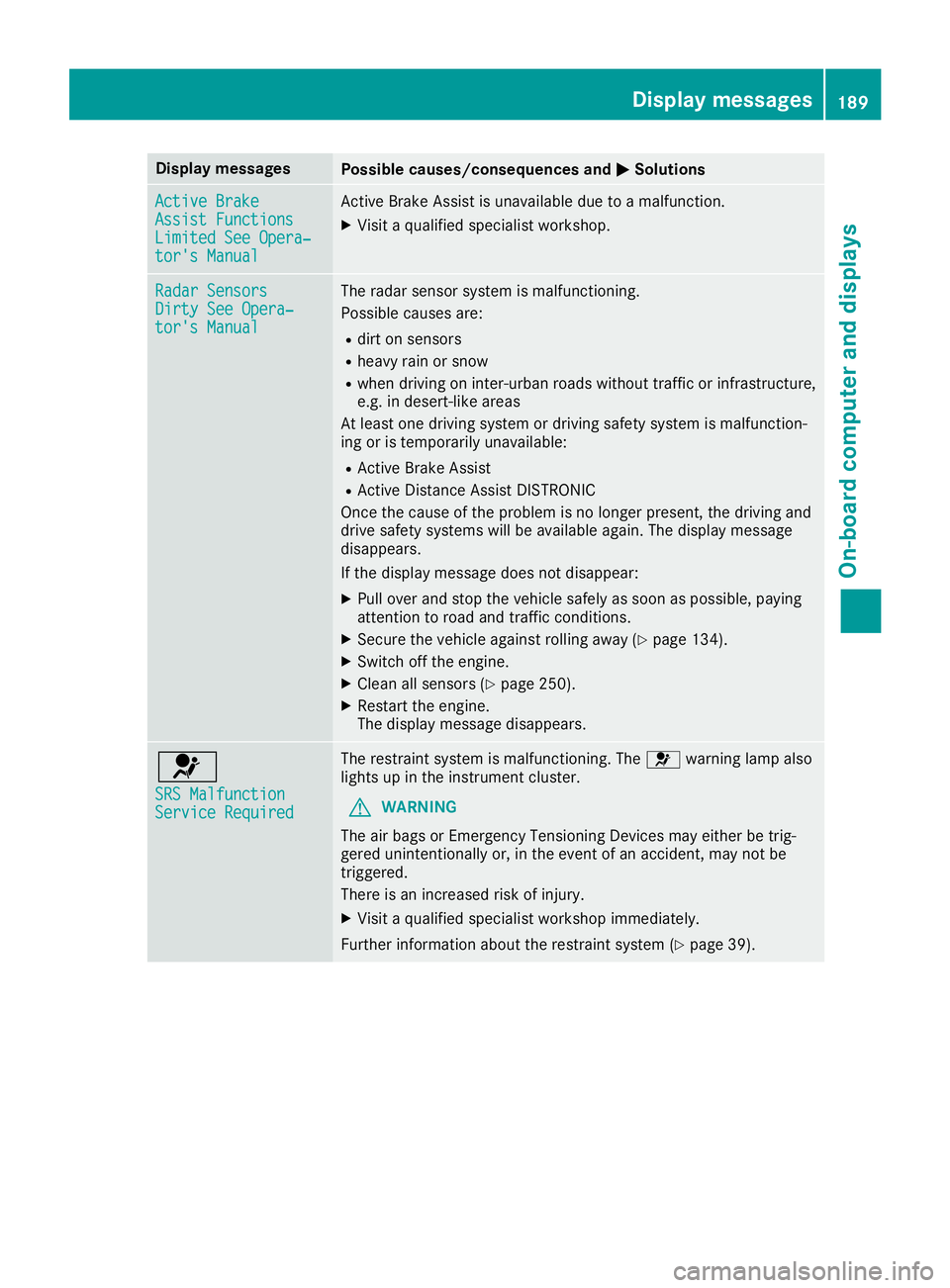
Disp
laymes sages Poss
iblecauses/co nsequences and 0050 0050
Solu tions Act
ive Brake Act
ive Brake
Ass ist Functions Ass
ist Functions
Lim itedSee Opera‐ Lim
itedSee Opera‐
tor 'sManual tor
'sManual Ac
tive Brake Assis tis unav ailable duetoamalf unction .
X Vis itaqualif iedspecialistwor kshop . Rad
arSensors Rad
arSensors
Dir tySee Opera‐ Dir
tySee Opera‐
tor 'sManual tor
'sManual The
radar sensor syst emismalf unction ing .
Pos siblecaus esare:
R dir ton sen sors
R heav yrain orsnow
R when drivin gon inter- urban roadswithout traff icor infras truct ure,
e. g. indes ert-like area s
At least onedri vin gsyst emordrivin gsaf etysyst emismalf unction -
ing oristempo rarilyunav ailable :
R Ac tive Brake Assis t
R Ac tive Distanc eAs sis tDI ST RONI C
On ce thecaus eof thepro blem isno longer presen t,th edri vin gand
dri ve saf etysyst ems willbeavail able again .The displaymes sage
disap pears.
If th edisp laymes sage does notdisap pear:
X Pull overand stop theveh iclesaf ely assoo nas pos sible,payin g
att ention toroa dand traff icco nd ition s.
X Se cur eth eveh icleagain strol lingaway (Ypage 134).
X Swi tchoff theen gin e.
X Clean allsen sors(Y page 250).
X Rest arttheen gin e.
The displaymes sage disap pears. 0075
SRS Malfunction SRS
Malfunction
Ser viceReq uir ed Ser
viceReq uir ed The
restrain tsyst emismalf unction ing .The 0075 warninglamp also
ligh tsup intheins trumen tclus ter.
G WAR
NING
The airbags orEm erg ency Ten sion ingDevic es may either betrig-
ger eduninten tion ally or,intheeve ntofan acc iden t,may notbe
tr igge red.
The reisan increas edriskof injury.
X Vis itaqualif iedspecialistwor kshop immediat ely.
Fur ther inform ation about theres train tsyst em(Ypage 39). Disp
laymes sage s
189On -boar dcomp uter anddi sp lay s Z